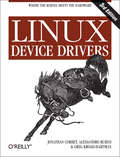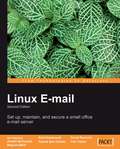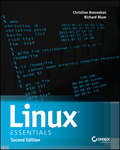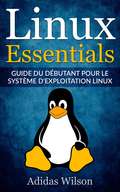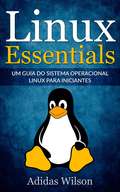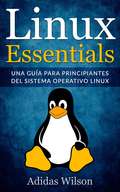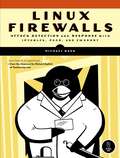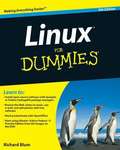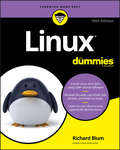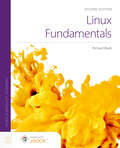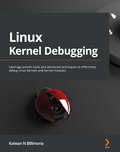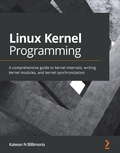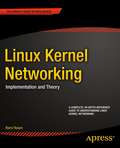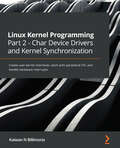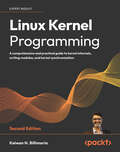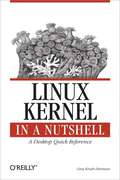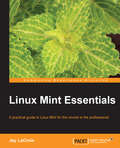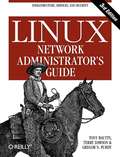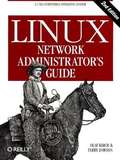- Table View
- List View
Linux Device Drivers: Where the Kernel Meets the Hardware
by Jonathan Corbet Alessandro Rubini Greg Kroah-HartmanDevice drivers literally drive everything you're interested in--disks, monitors, keyboards, modems--everything outside the computer chip and memory. And writing device drivers is one of the few areas of programming for the Linux operating system that calls for unique, Linux-specific knowledge. For years now, programmers have relied on the classic Linux Device Drivers from O'Reilly to master this critical subject. Now in its third edition, this bestselling guide provides all the information you'll need to write drivers for a wide range of devices.Over the years the book has helped countless programmers learn:how to support computer peripherals under the Linux operating systemhow to develop and write software for new hardware under Linuxthe basics of Linux operation even if they are not expecting to write a driverThe new edition of Linux Device Drivers is better than ever. The book covers all the significant changes to Version 2.6 of the Linux kernel, which simplifies many activities, and contains subtle new features that can make a driver both more efficient and more flexible. Readers will find new chapters on important types of drivers not covered previously, such as consoles, USB drivers, and more.Best of all, you don't have to be a kernel hacker to understand and enjoy this book. All you need is an understanding of the C programming language and some background in Unix system calls. And for maximum ease-of-use, the book uses full-featured examples that you can compile and run without special hardware.Today Linux holds fast as the most rapidly growing segment of the computer market and continues to win over enthusiastic adherents in many application areas. With this increasing support, Linux is now absolutely mainstream, and viewed as a solid platform for embedded systems. If you're writing device drivers, you'll want this book. In fact, you'll wonder how drivers are ever written without it.
Linux Email
by Alistair Mcdonald Carl TaylorThe book takes a practical, step-by-step approach to working with email servers. It starts by establishing the basics and setting up a mail server. Then you move to advanced sections like webmail access, security, backup, and more. You will find many examples and clear explanations that will facilitate learning. This book is aimed at technically confident users and new and part-time system administrators in small businesses, who want to set up a Linux-based email server without spending a lot of time becoming expert in the individual applications. Basic knowledge of Linux is expected.
Linux Essentials
by Richard Blum Christine BresnahanLearn Linux, and take your career to the next level! Linux Essentials, 2nd Edition provides a solid foundation of knowledge for anyone considering a career in information technology, for anyone new to the Linux operating system, and for anyone who is preparing to sit for the Linux Essentials Exam. Through this engaging resource, you can access key information in a learning-by-doing style. Hands-on tutorials and end-of-chapter exercises and review questions lead you in both learning and applying new information-information that will help you achieve your goals! With the experience provided in this compelling reference, you can sit down for the Linux Essentials Exam with confidence. An open source operating system, Linux is a UNIX-based platform that is freely updated by developers. The nature of its development means that Linux is a low-cost and secure alternative to other operating systems, and is used in many different IT environments. Passing the Linux Essentials Exam prepares you to apply your knowledge regarding this operating system within the workforce. Access lessons that are organized by task, allowing you to quickly identify the topics you are looking for and navigate the comprehensive information presented by the book Discover the basics of the Linux operating system, including distributions, types of open source applications, freeware, licensing, operations, navigation, and more Explore command functions, including navigating the command line, turning commands into scripts, and more Identify and create user types, users, and groups Linux Essentials, 2nd Edition is a critical resource for anyone starting a career in IT or anyone new to the Linux operating system.
Linux Essentials
by Roderick W. SmithA unique, full-color introduction to Linux fundamentalsServing as a low-cost, secure alternative to expensive operating systems, Linux is a UNIX-based, open source operating system. Full-color and concise, this beginner's guide takes a learning-by-doing approach to understanding the essentials of Linux. Each chapter begins by clearly identifying what you will learn in the chapter, followed by a straightforward discussion of concepts that leads you right into hands-on tutorials. Chapters conclude with additional exercises and review questions, allowing you to reinforce and measure your understanding.Offers a hands-on approach to acquiring a foundation of Linux skills, aiming to ensure Linux beginners gain a solid understandingUses the leading Linux distribution Fedora to demonstrate tutorials and examplesAddresses Linux installation, desktop configuration, management of files and filesystems, remote administration, security, and moreThis book is essential reading for anyone entering the world of Linux!
Linux Essentials: Guide du débutant pour le système d'exploitation Linux
by Adidas WilsonLinux est le seul système d'exploitation qui est en croissance globalement. Comme l’a dit une personne, «Linux est le Nikola Tesla de la technologie de l’information». Ce système d'exploitation est utilisé dans une multitude d'appareils, notamment les téléphones intelligents, les enregistreurs vidéo numériques, les téléviseurs, les systèmes de divertissement en vol, la signalisation numérique, les systèmes de contrôle automobile, les commutateurs, les routeurs, les ordinateurs de bureau, etc. Le débat entre Microsoft Windows et le système d'exploitation Linux ne se terminera pas de si tôt. Cependant, il est très clair que Linux est en train de gagner. Si vous avez du mal à le croire, considérez l’influence de Linux sur les appareils Apple basés sur Android et UNIX. La seule raison pour laquelle Windows est encore courant est son influence sur de nombreuses applications principales. Ceci est sur le point de changer et Linux est sans aucun doute l'avenir. Microsoft est le roi du End User Computing (EUC) depuis environ 30 ans. Néanmoins, des facteurs tels que des problèmes de sécurité poussent l’EUC vers le centre de données. Pour cette raison, il est souhaitable de réduire les coûts et les risques nécessaires pour maintenir Windows sur le bord. Le système d'exploitation Linux offre la solution parfaite pour cela. Linux est léger et est en couches, ce qui lui permet d’être très performant sur de nombreux types de périphériques. Il offre également une vitesse et une réactivité élevées. Etant donné que Linux présente de nombreux avantages, il est préférable pour les applications de points de terminaison.
Linux Essentials: um guia do sistema operacional Linux para iniciantes
by Adidas WilsonLinux é o único sistema operacional endpoint que está crescendo globalmente. Como uma pessoa disse, "Linux é o Nikola Tesla da tecnologia da informação". Este sistema operacional é usado em uma infinidade de dispositivos, incluindo smartphones, gravadores de vídeo digital, televisores, sistemas de entretenimento de companhias aéreas, assinatura digital, sistemas de controle de automóveis, interruptores, roteadores, desktop, entre muitos outros.O debate entre Windows da Microsoft vs SO Linux não terminará tão cedo. No entanto, está muito claro que o Linux está ganhando. Se você tem dificuldade em acreditar nisso, considere a influência do Linux nos dispositivos Apple baseados em UNIX e dispositivos Android. O único motivo pelo qual o Windows ainda é comum é sua influência em muitos aplicativos populares. Isso está prestes a mudar e o Linux é, sem dúvida, o futuro. A Microsoft é a rainha da EUC (Computação do Usuário Final) há cerca de 30 anos. No entanto, existem fatores, como questões de segurança, que estão empurrando a EUC para o data center. Devido a isso, existe o desejo de reduzir os custos e riscos necessários para manter o Windows como tecnologia de ponta. O sistema operacional Linux oferece a solução perfeita para isso. O Linux é em camadas e leve, o que permite um desempenho muito bom em muitos tipos de dispositivos. Ele também oferece alta velocidade e capacidade de resposta. Como o Linux tem muitas vantagens inerentes, ele é preferido para aplicativos de terminal.
Linux Essentials: una guía para principiantes del sistema operativo Linux
by Adidas WilsonLinux es el único sistema operativo de punto final que está creciendo globalmente. Como dijo una persona, "Linux es el Nikola Tesla de la tecnología de la información". Este sistema operativo se usa en una gran variedad de dispositivos que incluyen teléfonos inteligentes, grabadoras de video digital, televisores, sistemas de entretenimiento de aerolíneas, señalización digital, sistemas de control de automóviles, conmutadores, enrutadores, ordenadores de escritorio, entre muchos otros. El debate del sistema operativo Microsoft Windows vs Linux no terminará pronto. Sin embargo, es muy claro que Linux está ganando. Si le cuesta creerlo, considere la influencia de Linux en dispositivos Apple basados en Android y UNIX. La única razón por la que Windows todavía es común es debido a su influencia en muchas aplicaciones básicas. Esto está a punto de cambiar, y Linux es, sin lugar a dudas, el futuro. Microsoft ha sido el rey de la computación del usuario final (EUC) durante aproximadamente 30 años. No obstante, hay factores como los problemas de seguridad que impulsan a EUC al centro de datos. Debido a esto, existe el deseo de reducir los costos y riesgos que se requieren para mantener Windows al límite. El sistema operativo Linux ofrece la solución perfecta para esto. Linux tiene capas y es ligero, lo que le permite funcionar muy bien en muchos tipos de dispositivos. También ofrece alta velocidad y capacidad de respuesta. Debido a que Linux tiene muchas ventajas inherentes, se prefiere para aplicaciones de punto final.
Linux Firewalls: Attack Detection and Response
by Michael RashSystem administrators need to stay ahead of new security vulnerabilities that leave their networks exposed every day. A firewall and an intrusion detection systems (IDS) are two important weapons in that fight, enabling you to proactively deny access and monitor network traffic for signs of an attack.Linux Firewalls discusses the technical details of the iptables firewall and the Netfilter framework that are built into the Linux kernel, and it explains how they provide strong filtering, Network Address Translation (NAT), state tracking, and application layer inspection capabilities that rival many commercial tools. You'll learn how to deploy iptables as an IDS with psad and fwsnort and how to build a strong, passive authentication layer around iptables with fwknop.Concrete examples illustrate concepts such as firewall log analysis and policies, passive network authentication and authorization, exploit packet traces, Snort ruleset emulation, and more with coverage of these topics:–Passive network authentication and OS fingerprinting–iptables log analysis and policies–Application layer attack detection with the iptables string match extension–Building an iptables ruleset that emulates a Snort ruleset–Port knocking vs. Single Packet Authorization (SPA)–Tools for visualizing iptables logsPerl and C code snippets offer practical examples that will help you to maximize your deployment of Linux firewalls. If you're responsible for keeping a network secure, you'll find Linux Firewalls invaluable in your attempt to understand attacks and use iptables—along with psad and fwsnort—to detect and even prevent compromises.
Linux For Dummies
by Richard BlumOne of the fastest ways to learn Linux is with this perennial favoriteEight previous top-selling editions of Linux For Dummies can't be wrong. If you've been wanting to migrate to Linux, this book is the best way to get there. Written in easy-to-follow, everyday terms, Linux For Dummies 9th Edition gets you started by concentrating on two distributions of Linux that beginners love: the Ubuntu LiveCD distribution and the gOS Linux distribution, which comes pre-installed on Everex computers. The book also covers the full Fedora distribution.Linux is an open-source operating system and a low-cost or free alternative to Microsoft Windows; of numerous distributions of Linux, this book covers Ubuntu Linux, Fedora Core Linux, and gOS Linux, and includes them on the DVD.Install new open source software via Synaptic or RPM package managersUse free software to browse the Web, listen to music, read e-mail, edit photos, and even run Windows in a virtualized environmentGet acquainted with the Linux command lineIf you want to get a solid foundation in Linux, this popular, accessible book is for you.Note: CD-ROM/DVD and other supplementary materials are not included as part of eBook file.
Linux For Dummies
by Richard BlumYour step-by-step guide to the latest in Linux Nine previous editions of this popular benchmark guide can’t be wrong! Whether you’re new to Linux and need a step-by-step guide or are a pro who wants to catch up with recent distributions, Linux For Dummies, 10th Edition has your back. Covering everything from installation to automation, this updated edition focuses on openSUSE and Ubuntu and includes new and refreshed material—as well as chapters on building a web server and creating simple shell scripts. In his friendly, no-jargon style, IT professional and tech higher education instructor Richard Blum draws on more than 10 years of teaching to show you just why Linux’s open source operating systems are relied on to run a huge proportion of the world’s online infrastructure, servers, supercomputers, and NAS devices—and how you can master them too. Study the thinking behind Linux Choose the right installation approach Pick up the basics—from prepping to desktops Get fancy with music, video, movies, and games Whatever your Linux needs—work, fun, or just a hobby—this bestselling, evergreen guide will get you up and coding in the open source revolution in no time at all.
Linux Fundamentals
by Richard BlumThe Linux world is constantly changing, requiring new knowledge and skills to work as a Linux system administrator. Linux Fundamentals, Second Edition not only updates the first edition with new material, but also changes the book’s focus a bit, from a basic approach to Linux to a more advanced server-oriented look at using Linux. While the first edition tracked the skills needed to meet the LPI Linux Fundamentals exam requirements, this edition tracks the more advanced CompTIA Linux+ exam requirements. The Second Edition provides a soft, accessible, and practical introduction to Linux environments and command line basics. The addition of new virtual labs will also empower students to apply theory in hands-on exercises in real time. This edition dives deeper into the Linux server environment, covering the commands you are expected to know for the Linux+ exam.
Linux Kernel Debugging: Leverage proven tools and advanced techniques to effectively debug Linux kernels and kernel modules
by Kaiwan N BillimoriaEffectively debug kernel modules, device drivers, and the kernel itself by gaining a solid understanding of powerful open source tools and advanced kernel debugging techniquesKey FeaturesFully understand how to use a variety of kernel and module debugging tools and techniques using examplesLearn to expertly interpret a kernel Oops and identify underlying defect(s)Use easy-to-look up tables and clear explanations of kernel-level defects to make this complex topic easyBook DescriptionThe Linux kernel is at the very core of arguably the world's best production-quality OS. Debugging it, though, can be a complex endeavor.Linux Kernel Debugging is a comprehensive guide to learning all about advanced kernel debugging. This book covers many areas in-depth, such as instrumentation-based debugging techniques (printk and the dynamic debug framework), and shows you how to use Kprobes. Memory-related bugs tend to be a nightmare – two chapters are packed with tools and techniques devoted to debugging them. When the kernel gifts you an Oops, how exactly do you interpret it to be able to debug the underlying issue? We've got you covered. Concurrency tends to be an inherently complex topic, so a chapter on lock debugging will help you to learn precisely what data races are, including using KCSAN to detect them. Some thorny issues, both debug- and performance-wise, require detailed kernel-level tracing; you'll learn to wield the impressive power of Ftrace and its frontends. You'll also discover how to handle kernel lockups, hangs, and the dreaded kernel panic, as well as leverage the venerable GDB tool within the kernel (KGDB), along with much more.By the end of this book, you will have at your disposal a wide range of powerful kernel debugging tools and techniques, along with a keen sense of when to use which.What you will learnExplore instrumentation-based printk along with the powerful dynamic debug frameworkUse static and dynamic Kprobes to trap into kernel/module functionsCatch kernel memory defects with KASAN, UBSAN, SLUB debug, and kmemleakInterpret an Oops in depth and precisely identify it's source locationUnderstand data races and use KCSAN to catch evasive concurrency defectsLeverage Ftrace and trace-cmd to trace the kernel flow in great detailWrite a custom kernel panic handler and detect kernel lockups and hangsUse KGDB to single-step and debug kernel/module source codeWho this book is forThis book is for Linux kernel developers, module/driver authors, and testers interested in debugging and enhancing their Linux systems at the level of the kernel. System administrators who want to understand and debug the internal infrastructure of their Linux kernels will also find this book useful. A good grasp on C programming and the Linux command line is necessary. Some experience with kernel (module) development will help you follow along.
Linux Kernel Development Cookbook: A comprehensive guide to kernel internals, writing kernel modules, and kernel synchronization
by Kaiwan N BillimoriaThis book is for Linux programmers who are beginning to find their way with kernel development. Kernel developers looking to overcome frequent and common kernel development issues will definitely benefit from this book.
Linux Kernel Networking
by Rami RosenLinux Kernel Networking takes you on a guided in-depth tour of the current Linux networking implementation and the theory behind it. Linux kernel networking is a complex topic, so the book won't burden you with topics not directly related to networking. This book will also not overload you with cumbersome line-by-line code walkthroughs not directly related to what you're searching for; you'll find just what you need, with in-depth explanations in each chapter and a quick reference at the end of each chapter. Linux Kernel Networking is the only up-to-date reference guide to understanding how networking is implemented, and it will be indispensable in years to come since so many devices now use Linux or operating systems based on Linux, like Android, and since Linux is so prevalent in the data center arena, including Linux-based virtualization technologies like Xen and KVM. What you'll learn *Kernel networking basics, including socket buffers *How key protocols like ARP, Neighbour Discovery and ICMP are implemented *In-depth looks at both IPv4 and IPv6 *Everything you need to know about Linux routing *How netfilter and IPsec are implemented *Linux wireless networking *Additional topics like Network Namespaces, NFC, IEEE 802. 15. 4, Bluetooth, InfiniBand and more Who this book is for Software developers and architects, project managers, CTOs, network admins and architects, network security professionals, computer science researchers, and Linux kernel hackers. A basic knowledge of C and networking is required; basic knowledge of the Linux kernel is helpful but not mandatory. Table of Contents 1. Introduction 2. Netlink Sockets 3. ICMP: Internet Control Message Protocol 4. IPv4 5. The IPv4 Routing Subsystem 6. Advanced Routing 7. Linux Neighboring Subsystem 8. IPv6 9. Netfilter 10. IPsec 11. Layer 4 Protocols 12. Wireless in Linux 13. InfiniBand 14. Advanced Topics Appendix A: Linux API Appendix B: Network Administration Appendix C: Glossary
Linux Kernel Programming Part 2 - Char Device Drivers and Kernel Synchronization: Create user-kernel interfaces, work with peripheral I/O, and handle hardware interrupts
by Kaiwan N BillimoriaDiscover how to write high-quality character driver code, interface with userspace, work with chip memory, and gain an in-depth understanding of working with hardware interrupts and kernel synchronizationKey FeaturesDelve into hardware interrupt handling, threaded IRQs, tasklets, softirqs, and understand which to use whenExplore powerful techniques to perform user-kernel interfacing, peripheral I/O and use kernel mechanismsWork with key kernel synchronization primitives to solve kernel concurrency issuesBook DescriptionLinux Kernel Programming Part 2 - Char Device Drivers and Kernel Synchronization is an ideal companion guide to the Linux Kernel Programming book. This book provides a comprehensive introduction for those new to Linux device driver development and will have you up and running with writing misc class character device driver code (on the 5.4 LTS Linux kernel) in next to no time. You'll begin by learning how to write a simple and complete misc class character driver before interfacing your driver with user-mode processes via procfs, sysfs, debugfs, netlink sockets, and ioctl. You'll then find out how to work with hardware I/O memory. The book covers working with hardware interrupts in depth and helps you understand interrupt request (IRQ) allocation, threaded IRQ handlers, tasklets, and softirqs. You'll also explore the practical usage of useful kernel mechanisms, setting up delays, timers, kernel threads, and workqueues. Finally, you'll discover how to deal with the complexity of kernel synchronization with locking technologies (mutexes, spinlocks, and atomic/refcount operators), including more advanced topics such as cache effects, a primer on lock-free techniques, deadlock avoidance (with lockdep), and kernel lock debugging techniques. By the end of this Linux kernel book, you'll have learned the fundamentals of writing Linux character device driver code for real-world projects and products.What you will learnGet to grips with the basics of the modern Linux Device Model (LDM)Write a simple yet complete misc class character device driverPerform user-kernel interfacing using popular methodsUnderstand and handle hardware interrupts confidentlyPerform I/O on peripheral hardware chip memoryExplore kernel APIs to work with delays, timers, kthreads, and workqueuesUnderstand kernel concurrency issuesWork with key kernel synchronization primitives and discover how to detect and avoid deadlockWho this book is forAn understanding of the topics covered in the Linux Kernel Programming book is highly recommended to make the most of this book. This book is for Linux programmers beginning to find their way with device driver development. Linux device driver developers looking to overcome frequent and common kernel/driver development issues, as well as perform common driver tasks such as user-kernel interfaces, performing peripheral I/O, handling hardware interrupts, and dealing with concurrency will benefit from this book. A basic understanding of Linux kernel internals (and common APIs), kernel module development, and C programming is required.
Linux Kernel Programming: A comprehensive and practical guide to kernel internals, writing modules, and kernel synchronization
by Kaiwan N. BillimoriaGain both a firm practical understanding and sufficient theoretical insight into the inner workings of Linux kernel internals, learn to write high-quality kernel module code, understand the complexities of kernel synchronization Purchase of the print or Kindle book includes a free eBook in PDF format.Key FeaturesDiscover how to write Linux kernel and module code for real-world productsImplement industry-grade techniques in real-world scenarios for fast, efficient memory allocation and data synchronizationUnderstand and exploit kernel architecture, CPU scheduling, and kernel synchronization techniquesBook DescriptionThe 2nd Edition of Linux Kernel Programming is an updated, comprehensive guide for new programmers to the Linux kernel. This book uses the recent 6.1 Long-Term Support (LTS) Linux kernel series, which will be maintained until Dec 2026, and also delves into its many new features. Further, the Civil Infrastructure Project has pledged to maintain and support this 6.1 Super LTS (SLTS) kernel right until August 2033, keeping this book valid for years to come! You’ll begin this exciting journey by learning how to build the kernel from source. In a step by step manner, you will then learn how to write your first kernel module by leveraging the kernel’s powerful Loadable Kernel Module (LKM) framework. With this foundation, you will delve into key kernel internals topics including Linux kernel architecture, memory management, and CPU (task) scheduling. You’ll finish with understanding the deep issues of concurrency, and gain insight into how they can be addressed with various synchronization/locking technologies (e.g., mutexes, spinlocks, atomic/refcount operators, rw-spinlocks and even lock-free technologies such as per-CPU and RCU). By the end of this book, you’ll have a much better understanding of the fundamentals of writing the Linux kernel and kernel module code that can straight away be used in real-world projects and products.What you will learnConfigure and build the 6.1 LTS kernel from sourceWrite high-quality modular kernel code (LKM framework) for 6.x kernelsExplore modern Linux kernel architectureGet to grips with key internals details regarding memory management within the kernelUnderstand and work with various dynamic kernel memory alloc/dealloc APIsDiscover key internals aspects regarding CPU scheduling within the kernel, including cgroups v2Gain a deeper understanding of kernel concurrency issuesLearn how to work with key kernel synchronization primitivesWho this book is forThis book is for beginner Linux programmers and developers looking to get started with the Linux kernel, providing a knowledge base to understand required kernel internal topics and overcome frequent and common development issues. A basic understanding of Linux CLI and C programming is assumed.
Linux Kernel in a Nutshell: A Desktop Quick Reference
by Greg Kroah-HartmanWritten by a leading developer and maintainer of the Linux kernel,Linux Kernel in a Nutshell is a comprehensiveoverview of kernel configuration and building, a critical task forLinux users and administrators. No distribution can provide a Linux kernel that meets all users'needs. Computers big and small have special requirements that requirereconfiguring and rebuilding the kernel. Whether you are trying toget sound, wireless support, and power management working on a laptopor incorporating enterprise features such as logical volume managementon a large server, you can benefit from the insights in this book. Linux Kernel in a Nutshell covers the entirerange of kernel tasks, starting with downloading the source and makingsure that the kernel is in sync with the versions of the tools youneed. In addition to configuration and installation steps, the bookoffers reference material and discussions of related topics such ascontrol of kernel options at runtime. A key benefit of the book is a chapter on determining exactly what drivers are needed for your hardware. Also included are recipes thatlist what you need to do to accomplish a wide range of popular tasks.
Linux Mint Essentials
by Jay LacroixA task-oriented look at Linux Mint, using actual real-world examples to stimulate learning. Each topic is presented in an easy-to-follow order, with hands-on activities to reinforce the content. If you are starting out with Linux from a different platform or are well versed with Linux Mint and want a guide that shows you how to exploit certain functionality, this book is for you. No previous Linux experience is assumed.
Linux Mint System Administrator’s Beginner's Guide
by Arturo Fernandez MontoroA concise Packt Beginner's Guide to get you started with administering a Linux Mint system. This book is for those users who want to become Linux Mint system administrators and need to start learning quickly. It's assumed that you have a basic knowledge of GNU/Linux operating systems, as well as being familiar with concepts, such as kernel, filesystems, users, accounts, groups, and disk partitions
Linux Multimedia Hacks: Tips & Tools for Taming Images, Audio, and Video
by Kyle RankinThe fact that Linux has more multimedia application choices than Mac OS X and Windows combined may come as a surprise to many, but not to those who know Linux well. In Linux Multimedia Hacks, author Kyle Rankin showcases the best available multimedia tools so you can maximize the entertainment capabilities of your favorite OS. Included are tips and tricks for connecting to iPods, creating MP3s and Oggs, watching and making DVDs, turning your Linux box into a Tivo ala MythTV, and much more.You don't have to be a Linux server guru to make use of this book. Linux Multimedia Hacks takes the best of Linux's multimedia tools and with step-by-step instructions shows even novice users how to do cool and useful things with images, audio, and video. It includes entry level hacks that nearly all Linux users will want, such as installing codecs for audio and video playback and managing thousands of photographs. Later, you'll find hacks that cover a variety of advanced projects, from ripping and organizing media files with metatags, to editing video and audio tracks, to creating your own DVDs. Basic or advanced, each hack stands on its own, so you can feel free to jump around to only the sections that interest you.The book is divided into five easy-to-understand chapters:Images: tips range from basic image edits to automated image manipulationAudio: hacks include audio format conversion and tweaking metadata within audio filesVideo: learn how to covert between video formats, plus how to create your own VCDs and DVDsBroadcast Media: tips include how to access and create you own web broadcasts as well as watch and record TVWeb: learn how to make your multimedia creations available to the worldAs one of the most powerful multimedia platforms around, Linux has far more capabilities and features than meets the eye. This latest Hacks book gives you the technical chops to enjoy them all.
Linux Network Administrator's Guide, 3rd Edition
by Terry Dawson Tony Bautts Gregor N. PurdyThe Linux Network Administrator's Guide , Third Edition updates a classic Linux title from O'Reilly. This refreshed resource takes an in-depth look at everything you need to know to join a network. Topics covered include all of the essential networking software that comes with the Linux operating system, plus information on a host of cutting-edge services including wireless hubs, spam filtering, and more.
Linux Network Administrator's Guide, Second Edition
by Terry Dawson Olaf KirchFully updated, this impressive, comprehensive introduction to networking on Linux now covers firewalls, including the use of ipchains and iptables (netfilter), masquerading, and accounting. Other new topics include Novell (NCP/IPX) support and INN (news administration). Original material on serial connections, UUCP, routing and DNS, mail and News, SLIP and PPP, NFS, and NIS has been thoroughly updated.
Linux Networking Cookbook
by Gregory BoyceThis book is targeted at Linux systems administrators who have a good basic understanding and some prior experience of how a Linux machine operates, but want to better understand how various network services function, how to set them up, and how to secure them. You should be familiar with how to set up a Linux server and how to install additional software on them.
Linux Networking Cookbook: From Asterisk to Zebra with Easy-to-Use Recipes (Linux)
by Carla SchroderThis soup-to-nuts collection of recipes covers everything you need to know to perform your job as a Linux network administrator, whether you're new to the job or have years of experience. With Linux Networking Cookbook, you'll dive straight into the gnarly hands-on work of building and maintaining a computer network.Running a network doesn't mean you have all the answers. Networking is a complex subject with reams of reference material that's difficult to keep straight, much less remember. If you want a book that lays out the steps for specific tasks, that clearly explains the commands and configurations, and does not tax your patience with endless ramblings and meanderings into theory and obscure RFCs, this is the book for you.You will find recipes for:Building a gateway, firewall, and wireless access point on a Linux networkBuilding a VoIP server with AsteriskSecure remote administration with SSHBuilding secure VPNs with OpenVPN, and a Linux PPTP VPN serverSingle sign-on with Samba for mixed Linux/Windows LANsCentralized network directory with OpenLDAPNetwork monitoring with Nagios or MRTGGetting acquainted with IPv6Setting up hands-free networks installations of new systemsLinux system administration via serial consoleAnd a lot more. Each recipe includes a clear, hands-on solution with tested code, plus a discussion on why it works. When you need to solve a network problem without delay, and don't have the time or patience to comb through reference books or the Web for answers, Linux Networking Cookbook gives you exactly what you need.
Linux Observability with BPF: Advanced Programming for Performance Analysis and Networking
by David Calavera Lorenzo FontanaBuild your expertise in the BPF virtual machine in the Linux kernel with this practical guide for systems engineers. You’ll not only dive into the BPF program lifecycle but also learn to write applications that observe and modify the kernel’s behavior; inject code to monitor, trace, and securely observe events in the kernel; and more.Authors David Calavera and Lorenzo Fontana help you harness the power of BPF to make any computing system more observable. Familiarize yourself with the essential concepts you’ll use on a day-to-day basis and augment your knowledge about performance optimization, networking, and security. Then see how it all comes together with code examples in C, Go, and Python.Write applications that use BPF to observe and modify the Linux kernel’s behavior on demandInject code to monitor, trace, and observe events in the kernel in a secure way—no need to recompile the kernel or reboot the systemExplore code examples in C, Go, and PythonGain a more thorough understanding of the BPF program lifecycle
